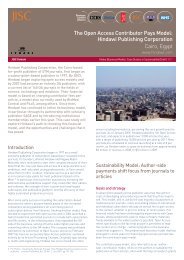A Concise Guide to Researching Audiences - Strategic Content ...
A Concise Guide to Researching Audiences - Strategic Content ...
A Concise Guide to Researching Audiences - Strategic Content ...
You also want an ePaper? Increase the reach of your titles
YUMPU automatically turns print PDFs into web optimized ePapers that Google loves.
GlossaryAudiencedevelopmentAudience satisfactionDigital service anddigital audienceEthnographicresearchFormative researchFront-end researchFocus groupImpact analysisReachSummative researchTarget audienceSegmentationUsabilityUser-centred designActivities carried out <strong>to</strong> increase the audience for a service or resource.Establishing if the audience is happy with the service that is being provided. For example, is ithappy with the quality/content/accessibility/comprehensiveness of the service? Interrogation ofaudience satisfaction is often done in tandem with audience analysis.In this guide, digital is used <strong>to</strong> refer <strong>to</strong> resources and/or services exploiting digitised content ordelivered via a digital channel. In most instances this means a service which is available online, butit also includes digitised resources distributed on CD and could include digital television serviceswhich share some of the characteristics of online digital services. Digital audience refers <strong>to</strong> theaudience for a digital service or resource.Research based on observations of human behaviour, carried out in a ‘naturalistic’ setting. Thiscan include ‘observation’ via au<strong>to</strong>mated recording devices and is sometimes extended <strong>to</strong> includeobservations of subjects made in a labora<strong>to</strong>ry – the crucial point is that behaviour in response <strong>to</strong>the relevant stimuli should be normal and that the presence of the researcher or the observationalequipment should not interfere with or affect the subject’s behaviour.In the context of service development and delivery, this term covers research carried out duringservice development work, as part of the development process, <strong>to</strong> provide feedback on the work.In the context of service development and delivery, this term covers research carried out in theplanning and preparation of a service.A group of individuals selected and assembled by the researcher <strong>to</strong> discuss and comment on the<strong>to</strong>pic under consideration. Subjects’ personal experience of the <strong>to</strong>pic and interactions amongstgroup members are the distinguishing features of the technique.Analysis of the longer-term effects of a service (or group of services) on its audience. Longer-termevaluation methods are required <strong>to</strong> determine if the impact of a service is lasting.In this guide, reach is used <strong>to</strong> refer <strong>to</strong> the number of people <strong>to</strong> whom a service or resource isavailable. Different from uptake, which refers <strong>to</strong> usage of the service or resource.In the context of service development this refers <strong>to</strong> evaluative research assessing the extent <strong>to</strong>which a service has met specific criteria for success.The intended audience for a service or resource.The process of dividing an audience in<strong>to</strong> different categories or segments on the basis of criteriarelevant <strong>to</strong> the service or resource under consideration. Segments are relatively homogeneous anddistinct from other segments with respect <strong>to</strong> the chosen characteristics.A measure of the quality of the user experience of a service or resource. It generally encompassesfac<strong>to</strong>rs such as ease of learning, efficiency of use, memorability, error frequency and severity, andsubjective satisfaction with the interface.A design philosophy which places the goals, expectations and skills of users at the centre of thedesign process: the service or product is designed <strong>to</strong> fit the user. Typically, users are involvedthroughout the design and development process, including user testing of the service or productwhilst it is under developmentGlossary PAGE 27



